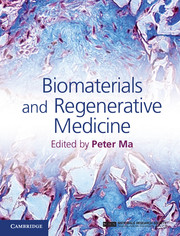Book contents
- Frontmatter
- Contents
- List of contributors
- Preface
- Part I Introduction to stem cells and regenerative medicine
- Part II Porous scaffolds for regenerative medicine
- 7 Nanofibrous polymer scaffolds with designed pore structure for regeneration
- 8 Electrospun micro/nanofibrous scaffolds
- 9 Biological scaffolds for regenerative medicine
- 10 Bioceramic scaffolds
- 11 Collagen-based tissue repair composite
- 12 Polymer/ceramic composite scaffolds for tissue regeneration
- 13 Computer-aided tissue engineering for modeling and fabrication of three-dimensional tissue scaffolds
- Part III Hydrogel scaffolds for regenerative medicine
- Part IV Biological factor delivery
- Part V Animal models and clinical applications
- Index
- References
9 - Biological scaffolds for regenerative medicine
from Part II - Porous scaffolds for regenerative medicine
Published online by Cambridge University Press: 05 February 2015
- Frontmatter
- Contents
- List of contributors
- Preface
- Part I Introduction to stem cells and regenerative medicine
- Part II Porous scaffolds for regenerative medicine
- 7 Nanofibrous polymer scaffolds with designed pore structure for regeneration
- 8 Electrospun micro/nanofibrous scaffolds
- 9 Biological scaffolds for regenerative medicine
- 10 Bioceramic scaffolds
- 11 Collagen-based tissue repair composite
- 12 Polymer/ceramic composite scaffolds for tissue regeneration
- 13 Computer-aided tissue engineering for modeling and fabrication of three-dimensional tissue scaffolds
- Part III Hydrogel scaffolds for regenerative medicine
- Part IV Biological factor delivery
- Part V Animal models and clinical applications
- Index
- References
Summary
Introduction
The ideal biological scaffold would provide structural support appropriate for the tissue of interest, and an adhesion surface that maintains phenotypic cues suited to the tissue and has the ability to change as the functional requirements of the target tissue change. The extracellular matrix (ECM) is the aggregate product of cells that reside in a given tissue, organ, or microenvironment and has all of these characteristics. In addition to serving as structural support for the tissue, the ECM has numerous functional roles that it fulfills through site-specific ligands that serve as cell-attachment anchors, differentiation cues, and mediators of intracellular signaling pathways. Furthermore, the ECM is in a constant state of “dynamic reciprocity” with the resident cells of the given tissues or organ, which is manifested by the temporal change in composition and structure in response to the requirements and activity of the resident cells that reside within the ECM. Stated differently, the composition and structure of the matrix are optimized for each tissue and change in response to mechanical forces, biochemical milieu, oxygen requirements/concentration, pH, and gene expression, among other factors. The ECM also plays a central role in mammalian development, normal physiology, and the response to injury. For these reasons, if harvested and processed appropriately, the ECM has been shown to promote constructive, site-specific remodeling when used as a biological scaffold for regenerative medicine applications.
Beginning with a discussion of the components that comprise the extracellular matrix, the present chapter will review the use of extracellular matrix as a biological scaffold material in tissue engineering and regenerative medicine applications with a specific focus on the mechanisms by which such scaffolds promote functional restoration of tissue following injury.
- Type
- Chapter
- Information
- Biomaterials and Regenerative Medicine , pp. 133 - 150Publisher: Cambridge University PressPrint publication year: 2014



